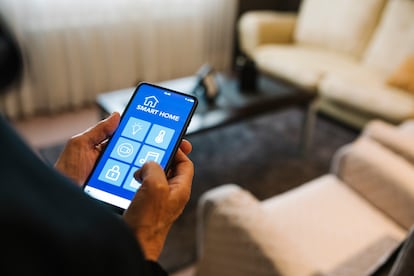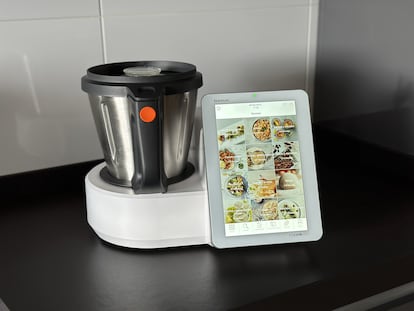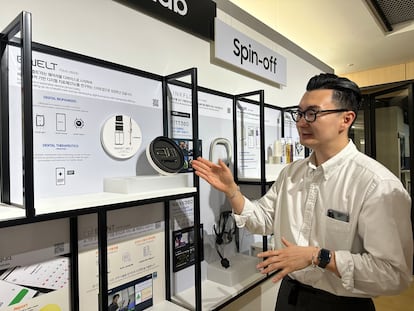Devices that make it seem like you’re home (even when you’ve gone on vacation)
Turning lights on and off, opening and closing the blinds, and making noise inside the house can keep burglars away. These gadgets allow you to do that from your cell phone

The police offer the following tip to help deter burglars from entering your home while you’re out: “Everything in your home that conveys the appearance of being inhabited will be very effective: do not lower the blinds completely and consider installing a programmable timer that lights the house by area, turning on and off lights and some appliances at different times.” This advice hints at what technology can do to improve home security. But what if, instead of a timer, we use smart bulbs that turn on and off at different times in different rooms? What if we automate the blinds? What if we use a smart assistant to replicate daily routines? There are multiple options, and your cell phone can control it all: you can manage and program all these gadgets with it remotely, so you do not have to concern yourself with such matters every day.
Starting with the basics
To simulate a presence in the home, one doesn’t need to have sophisticated devices. An item as basic as a smart plug can help turn the devices we already have at home — a lamp, the TV, any appliance — into smart ones. For a small price, you can program a device to turn on or off and even control energy consumption, among other things; the TP-Link Tapo 115 and Xiaomi Mi Smart Plug are good options for less than $30.
If you prefer to acquire standalone smart appliances, connected light bulbs are among the most affordable options. They have highly useful day-to-day features; smart bulbs are not just for when you go on vacation. In addition to being able to turn them on and off remotely, smart bulbs allow you to regulate the intensity of the light and even its warmth, depending on the task to be performed and the time of day (Philips Hue White Ambiance bulbs are one of the most complete models); other versions light up in different colors, such as the SPC Aura 1050.
Other devices that are notable for their ability to simulate a presence in the home are motion sensors, which can turn on lights in the hall or in a garden if they detect someone approaching (which would give the impression that a person was there doing it); automatic watering systems are also controllable from afar and can give the sense that plants have not been neglected; and smart speakers, such as the new Echo Pop or any from the Google Nest line, help control everything by voice and can play music or recorded conversations at different times of the day, for example.
However, not all devices are as inexpensive or easy to install as the above. Automation systems for opening and closing the blinds are one such example; however, they are particularly noteworthy because experts say that burglars typically look at whether the blinds are kept in the same position. That’s why lowering the blinds is important. To do so, you must first install a motor that allows them to go up and down electronically, such as the ones offered by companies like Somfy and Lexman; they are available for different sizes and can cost well over $200. Then you need to use a device that enables the motor to connect to the internet.
Automated routines
What happens when several smart devices in the house have the potential to simulate someone being at home? They can be used together to replicate what normally happens at home when one gets up, comes home in the evening and goes to bed. Smart assistants (Alexa, Google Assistant, Siri) can all create those scenes through their apps. Thus, they can be configured to open the blinds at a certain time and start playing the radio in the morning; in the evening, they can turn on the lights and TV in the living room; and at bedtime they can lower the blinds and turn everything off.
Sign up for our weekly newsletter to get more English-language news coverage from EL PAÍS USA Edition
Tu suscripción se está usando en otro dispositivo
¿Quieres añadir otro usuario a tu suscripción?
Si continúas leyendo en este dispositivo, no se podrá leer en el otro.
FlechaTu suscripción se está usando en otro dispositivo y solo puedes acceder a EL PAÍS desde un dispositivo a la vez.
Si quieres compartir tu cuenta, cambia tu suscripción a la modalidad Premium, así podrás añadir otro usuario. Cada uno accederá con su propia cuenta de email, lo que os permitirá personalizar vuestra experiencia en EL PAÍS.
¿Tienes una suscripción de empresa? Accede aquí para contratar más cuentas.
En el caso de no saber quién está usando tu cuenta, te recomendamos cambiar tu contraseña aquí.
Si decides continuar compartiendo tu cuenta, este mensaje se mostrará en tu dispositivo y en el de la otra persona que está usando tu cuenta de forma indefinida, afectando a tu experiencia de lectura. Puedes consultar aquí los términos y condiciones de la suscripción digital.
More information
Archived In
Últimas noticias
Pinochet’s victims grapple with José Antonio Kast’s rise in Chile
Reinhard Genzel, Nobel laureate in physics: ‘One-minute videos will never give you the truth’
How Japan is trying to avert ‘digital defeat’
The complicated life of Francesca Albanese: A rising figure in Italy but barred from every bank by Trump’s sanctions
Most viewed
- Pablo Escobar’s hippos: A serious environmental problem, 40 years on
- Why we lost the habit of sleeping in two segments and how that changed our sense of time
- Charles Dubouloz, mountaineering star, retires at 36 with a farewell tour inspired by Walter Bonatti
- Trump’s obsession with putting his name on everything is unprecedented in the United States
- The Florida Keys tourist paradise is besieged by immigration agents: ‘We’ve never seen anything like this’











































